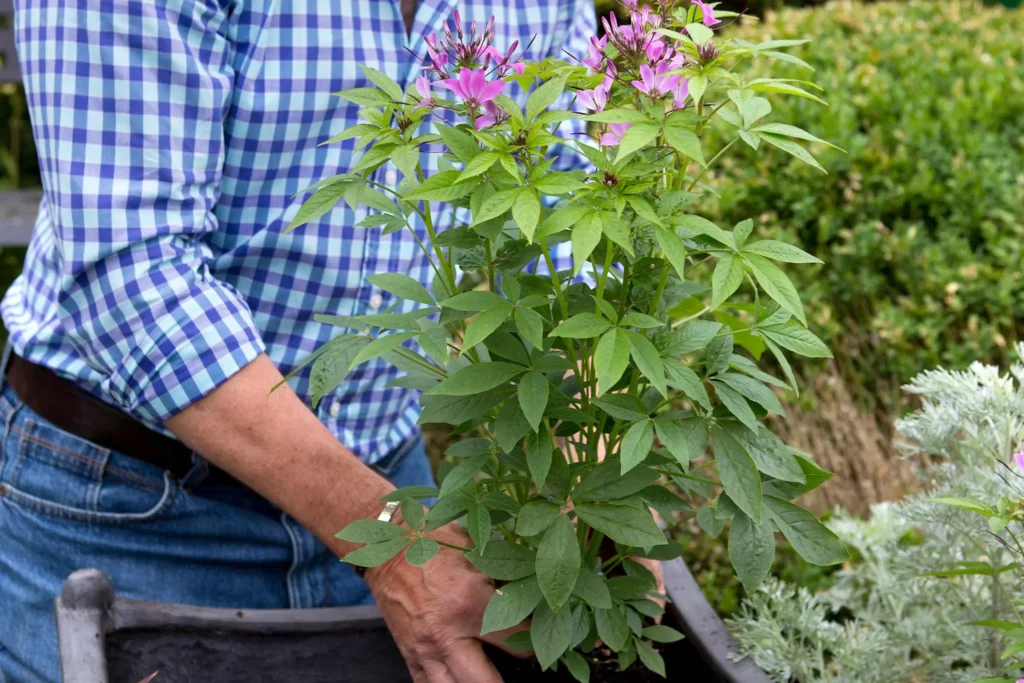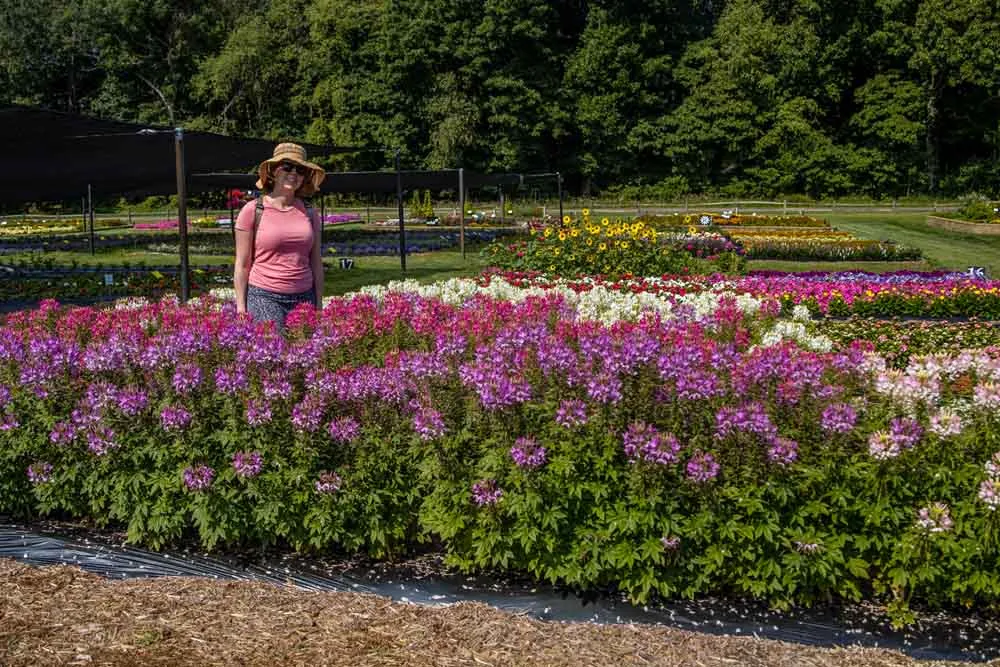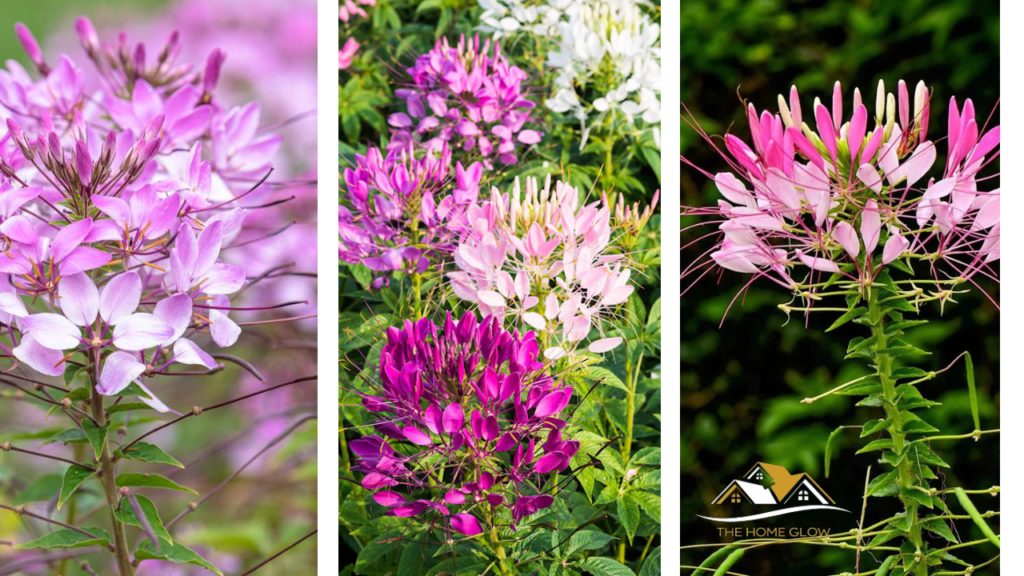Introduction
You buckle down on your open air desert spring yet are generally watching out for another thing to add to the impulsive notion. Cleome is a shocking choice. Here and there, Cleome gets everyone’s attention, standing apart with a novel, effortless appearance. You can’t request more brilliant flower tones, blasting out and seeming to be a bug plant, just prettier. When you have a deep understanding of Cleome care, they’ll compensate you with devoted blossoms.
Read More: Bougainvillea: Planting, Cultivation, and Growth Tips
Transforming your garden into a vibrant oasis doesn’t have to be a daunting task. With the enchanting Cleome flowers, you can effortlessly add bursts of color and charm to your outdoor haven. In this comprehensive guide, we’ll delve into the wonders of Cleome flowers and how they can elevate your garden into a colorful sanctuary.

How Cleome Flowers Transform Your Garden into a Colorful Haven
Cleome flowers have a transformative effect on garden landscapes, infusing them with vibrant colors and enchanting beauty. Here’s how these captivating blooms can turn your garden into a colorful haven:
- Dazzling Color Palette: With their stunning array of hues ranging from soft pastels to vibrant jewel tones, Cleome flowers add a pop of color that brightens up any garden space.
- Vertical Interest: The tall, graceful stems of Cleome flowers create vertical interest and visual appeal, adding depth and dimension to your garden beds and borders.
- Attract Pollinators: Cleome flowers are a magnet for pollinators, including bees, butterflies, and hummingbirds, enhancing biodiversity and promoting a healthy ecosystem in your garden.
- Low Maintenance Beauty: Easy to grow and care for, Cleome flowers require minimal maintenance while delivering maximum impact, making them an ideal choice for busy gardeners.
Charming Cleomes

These plants come in various varieties, sizes, and shapes. Their bug-like plan surfaces in your nursery. Add to the visual effect, Cleome leaves look frilly, as though dressed for the ball. These blossoms are open minded toward low temperatures and dry seasons. That implies you will not need to water as frequently as you do with different plants.
Read Article: 25 Stunning Black White and Gold Bathroom Ideas
Conventional Cleomes are pink or white, however outlandish mixtures have taken the variety range further. These plants can become obtrusive, yet dead-heading them forestalls that. While they’re pretty, you can nibble on their leaves! Murmur… bloom nursery or vegetable fix?
Outdoor Cleome Care
Cleome is otherwise called Bug Blossom. It’s a startling bit of whim in your nursery. The blossoms are tall on tall, meager stems. You truly can’t miss them in the scene.
Open air Cleome Care
There are some keys to effective Cleome care. Ensure it gets full sun and that you plant it in well-depleting soil where the dampness will be generally predictable. Assuming that you give these two things, you’ll have minimal in the method of support from there on.
In the event that you need consistent blossoms all through the season, just eliminate spent blossoms. Squeeze them off, leaving every one of the sound leaves close by in salvageable shape. Manures can likewise help Cleomes. Apply it month to month when they’re effectively developing.
Effortlessness and Speed: Landscapers value Cleome’s simple development. It’s a direct plant. When you sow it, the blossom develops rapidly. It’s consistently good to expediently see the aftereffects of your convenient work. While Cleomes are annuals, you might find new plants filling in spring thanks to the seeds from the past blooms shed.
Outdoor Cleome Needs
Begin with light. Your Cleome plants need six hours of direct daylight everyday. Without it, they don’t deliver many blossoms. Assuming they’re in the shade, the plants become leggy, searching for that light they want.
Before you put Cleomes in your nursery, correct the dirt with rich natural matter like excrement or manure. This assists the plant with holding dampness without getting waterlogged. On the off chance that you don’t know that it needs water, put your finger into the primary inch of soil close to the foundation of the Cleome. In the event that it’s dry, get out your watering can!

One of the most outstanding suggestions is getting to know your plants. Everything in your nursery has needs, however when you know them, you can save time and exertion. Cleomes are an exquisite plant certainly worth adding to your scene.
Read Post: 30 Best Teenage Girl Bedroom Ideas You Can’t Miss
Shopping for Outdoor Cleome Plants
You have a universe of Cleomes from which to pick, including smaller assortments. The following are a not many that could get your attention:
Mountain Honey bee Plant, which flaunts energetic pink or purple blossoms that draw in honey bees and butterflies. The Cleome cultivars, for example, the ‘Senorita Rosalita’ or ‘Sparkler Blush’, are smaller and offer a scope of varieties, including pink, purple, and white.
These assortments are known for their long blooming season and their capacity to flourish in different circumstances. Whether you favor the unconventional Insect Bloom or the minimal cultivars, Cleome plants add magnificence and appeal to any garden.
Read More: 10 Luxury Dining Tables That Will Wow Your Guests
Helen Campbell: A sensational white cultivar that got the RHS Grant of Nursery Legitimacy in 1993. It develops around 4 feet high by 2 feet wide and produces a light fragrance.
Linde Armstrong: In the event that you’re searching for a more modest Cleome, the Linde Armstrong develops to be just 1 foot by 1 foot. It is an Athens Select blossom, pretty in pink.
Mauve Sovereign: A 36-660 inch tall plant that hummingbirds love. The blossoms are a fresh mauve-pink that enhances your nursery as well as makes incredible blooms for game plans.
Rough Mountain Beeplant: A quickly developing Cleome that displays dry season resistance. They self-seed as the blossoms drop. Local Americans involved them as pot plants. Growing 26 inches tall, it would work delightfully with the universe.
Señorita Rosalita: This Cleome has no fragrance except for wonderful lavender blossoms spotting the stem and the top. Assuming you favor pink, search for Senorita Mi Love.
Sparkler: This series of crossovers develop to around 4 feet tall, and they’re shaggy. It “shines” with pink and white blossoms customarily, yet different tones are rose and lavender. It got a 2002 All-America Determinations grant.
Soul Series: These mixtures are minimal (2-3 feet tall). They branch and have intriguing blooms. Some, such as Appleblossom, are pink, blurring to white, for instance.
Violet Sovereign: This Cleome has a long blooming season. A stacked plant with violet blossoms doesn’t blur. Mature level 36″- 48″.
White Sovereign: Goodness! A 6-8 inch bloom head. You can’t miss it in any nursery. Blossoms in late-spring, growing 4-6 feet tall.
Cultivating Cleome Flowers: Tips for Success
Growing Cleome flowers is a rewarding experience that requires minimal effort and yields stunning results. Here are some essential tips for cultivating these enchanting blooms in your garden:
Selecting the Perfect Location
Choose a sunny spot in your garden with well-drained soil for optimal growth and bloom production. Some flowers thrive in full sun and require at least six to eight hours of direct sunlight daily.
Preparing the Soil
Before planting, prepare the soil by amending it with organic matter, such as compost or aged manure, to improve drainage and fertility. Cleome flowers prefer slightly acidic to neutral soil with a pH range of 6.0 to 7.0.
Planting Cleome Seeds or Seedlings
Cleome flowers can be grown from seeds or purchased as seedlings from nurseries or garden centers. Sow seeds directly into the ground after the last frost date or start seeds indoors 4-6 weeks before the last expected frost.
Providing Adequate Water and Nutrients
Water Cleome flowers regularly to keep the soil evenly moist but not waterlogged. Apply a balanced fertilizer once a month during the growing season to promote healthy growth and prolific blooming.
Supporting Tall Stems
Due to their tall growth habit, Cleome flowers may benefit from staking or support to prevent them from toppling over in strong winds or heavy rain. Use bamboo stakes or plant supports to provide stability and prevent stem breakage.
Deadheading Spent Blooms
To prolong the blooming period and encourage continuous flowering, deadhead blooms regularly by snipping them off at the base of the stem. This will redirect the plant’s energy into producing new blooms, ensuring a season-long display of color.
Enhancing Biodiversity with Cleome Flowers
Aside from their aesthetic appeal, Cleome flowers play a vital role in supporting biodiversity in the garden. Their nectar-rich blooms attract a diverse array of pollinators, including bees, butterflies, and hummingbirds, contributing to the health and vitality of the ecosystem. By planting Cleome flowers, you can create a haven for beneficial insects and pollinators, fostering a thriving and sustainable garden ecosystem.
See More: Secrets of Bedroom Design 2025
Conclusion
In conclusion, Cleome flowers are a versatile and enchanting addition to any garden landscape, transforming outdoor spaces into vibrant havens of color and beauty. With their striking appearance, easy care requirements, and ability to attract pollinators, Cleome flowers offer endless possibilities for gardeners seeking to create a captivating outdoor sanctuary. Whether planted as standalone features or incorporated into mixed borders, Cleome flowers are sure to delight and inspire with their charm and elegance. So why wait? Bring the magic of Cleome flowers into your garden today and watch as your outdoor oasis blossoms into a colorful haven of nature’s delight.
Frequently Asked Questions (FAQs)
1. Are Cleome flowers easy to grow?
Absolutely! Cleome flowers are low-maintenance plants that thrive in sunny locations with well-drained soil. With proper care and attention, you can enjoy a bountiful display of blooms throughout the growing season.
2. Do Cleome flowers attract pollinators?
Yes, Cleome flowers are highly attractive to pollinators such as bees, butterflies, and hummingbirds due to their nectar-rich blooms. By planting flowers in your garden, you can create a haven for beneficial insects and support local pollinator populations.
3. How tall do Cleome flowers grow?
Cleome flowers typically reach heights of 3 to 5 feet, making them ideal for adding vertical interest and structure to garden landscapes. Their towering stems and abundant blooms create a dramatic focal point that commands attention.
4. Can Cleome flowers tolerate hot weather?
Yes, Cleome flowers are well-suited to hot climates and thrive in sunny locations with warm temperatures. They are drought-tolerant once established and can withstand periods of heat and humidity with ease.
5. Do Cleome flowers self-seed?
Yes, Cleome flowers have a tendency to self-seed under favorable growing conditions. This means that once planted, they may produce volunteer seedlings in subsequent growing seasons, providing a continuous supply of blooms year after year.
6. How do I deadhead Cleome flowers?
To deadhead flowers, simply pinch off spent blooms at the base of the stem using your fingers or sharp pruners. This will encourage the plant to redirect its energy into producing new blooms, ensuring a prolonged flowering period.


